Delicious Japanese Soy Milk Hot Pot recipe with napa cabbage, mushrooms, and thinly sliced pork cooked in a creamy and savory soy milk broth.

Shabu Shabu and Sukiyaki are both very popular and well-known Japanese hot pot dishes outside of Japan. However, there are many other kinds of hot pot dishes that we also enjoy in Japan including Kimchi Nabe. Today I’d like to introduce Soy Milk Hot Pot, or as we call it Tonyu Nabe (豆乳鍋).
What is Soy Milk Hot Pot (Tonyu Nabe)?
As the name of the recipe suggests, one of the key ingredients for this hot pot is soy milk, which is used as the main flavoring for the base of dashi broth. Vegetables such as napa cabbage, leafy green vegetables, and thinly sliced pork are then added to cook in the hot pot and dipped in the ponzu sauce to enjoy. Meant to be a shared dish where friends and family gather together at the table to enjoy the dish, you can find soy milk hot pot being served at tofu restaurants or ryokan (Japanese inns).
The broth has a really delicate flavor. Due to the soy milk in the broth, the taste is naturally sweet and creamy. When all the vegetables and meats are submerged in the broth, everything comes together resulting in a well-rounded, savory hot pot. On the side, a tangy Ponzu sauce is served for you to dip the cooked vegetables and meats for an additional sweet, salty, and citrusy kick to the entire experience.
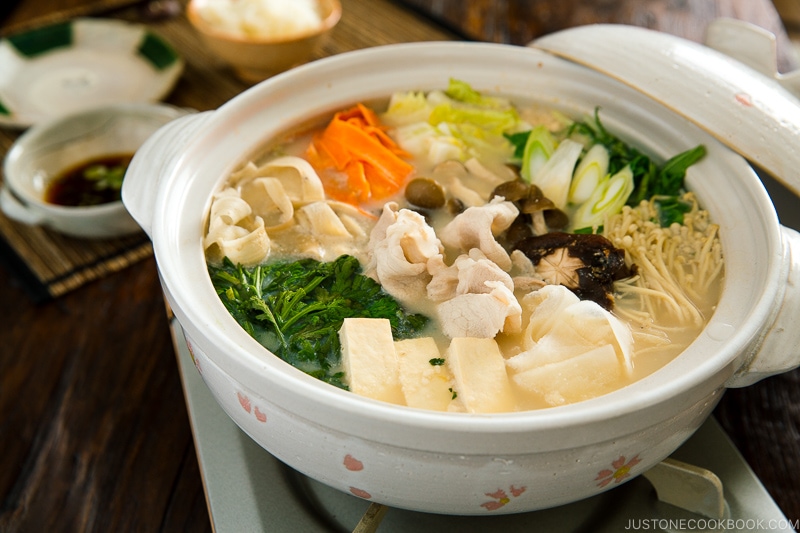
3 Big Flavors: Soy Milk, Miso, and Sesame Seeds
If you have tried my Vegetarian Ramen recipe, you’re probably familiar with the golden combination of these 3 big flavors.
Whenever soy milk is called for in many Japanese recipes, you will often find miso being used alongside. Like peanut butter and jelly, you gotta have one with the other. Soy milk is mild, sweet, and more neutral in flavor, while miso is rich, salty, and bold, which makes the duo the perfect pair in creating an umami-packed broth. Sesame seeds are optional, but I definitely prefer to add them as they add a toasty nutty aroma to the dish.

How To Prevent Soy Milk from Curdling
If I had to add one “challenging” part about this hot pot recipe, it is soy milk curdling. If you are like me who gets obsessive about skimming off the surface of broth until it’s nice and clean, this will probably bother you. You might end up skimming more than enjoying the hot pot.
Boiling or simmering can cause the soy milk to curdle. You can reduce curdles by cooking on a lower heat (without boiling), but it can’t be avoided from happening completely. Once you top the hot pot with vegetables and meat, the curdles will not be as visible after all.

Perfect Dinner for Busy Day
In case you’ve never made a hot pot at home, I can’t stress enough that there just aren’t many EASY & QUICK family meals than a hot pot. Here are quick 3 reasons why:
- Only one prep, which is cutting vegetables.
- Eat while you cook. The way we enjoy the hot pot is to sit around the hot pot (with a portable gas burner on the table). While each of your family members talks about their day, the meal is being cooked. When you’re enjoying hot food, the next batch of food is being cooked.
- The nutritious meal with all different (colors of) vegetables and protein in one meal.
To minimize your work for a family weeknight meal, you can prepare a big batch of vegetables in advance on the weekend. I often serve the soy milk hot pot with donabe, the traditional Japanese earthenware pot, but you can serve it with a different pot like Asian style steamboat or a large-size clay pot.
Soulful, wholesome and heart-warming, this soy milk hot pot is especially terrific when there’s a chill in the air. It also makes a cozy, fun dish to serve when you have a few guests over.
Other Hot Pot Recipes
Donabe Seasoning and Care
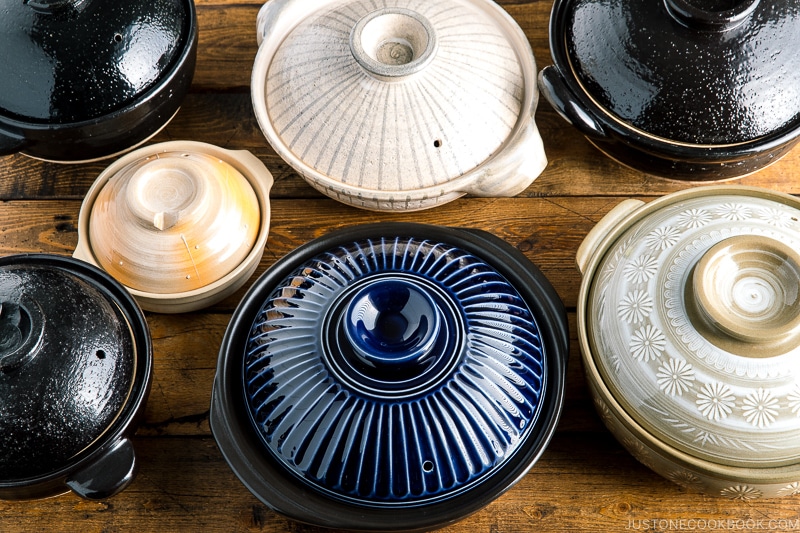
Wish to learn more about Japanese cooking? Sign up for our free newsletter to receive cooking tips & recipe updates! And stay in touch with me on Facebook, Pinterest, YouTube, and Instagram.
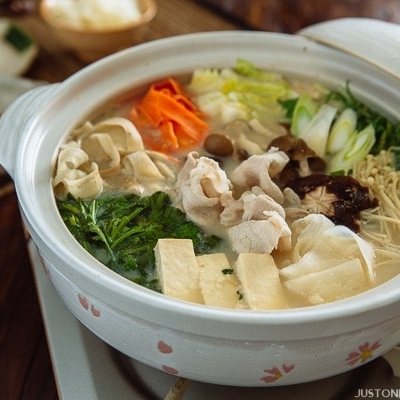
Soy Milk Hot Pot
Ingredients
- 1 lb thinly sliced pork loin (skip for vegetarian)
- 7 oz enoki mushrooms (1 package)
- 3.5 oz shimeji mushrooms (1 package)
- 4 shiitake mushrooms
- ¼ head napa cabbage (1.5 lb, 680 g)
- ½ bunch mizuna (Japanese mustard green) (or spinach or any leafy greens)
- 1 bunch shungiku (chrysanthemum greens) (or any leafy greens)
- 1 Tokyo negi (naga negi; long green onion) (or leek or green onions/scallions)
- 1 green onion/scallion
- 1 medium-firm tofu (momen dofu) (14 oz, 396 g)
- ½ daikon radish (1 lb, 454 g)
- 1 carrot (3 oz, 85 g)
- 1 gobo (burdock root) (5.3 oz, 150 g)
For the Hot Pot Soup
- 3 cups dashi (Japanese soup stock) (I use Awase Dashi; for vegan/vegetarian, make Vegan Dashi)
- ¼ cup sake
- ¼ cup mirin
- 2 cups unsweetened soy milk (microwave till it’s warm)
- ¼ cup miso
- 2 Tbsp toasted white sesame seeds
- ¼ tsp Diamond Crystal kosher salt (to taste)
Dipping Sauce
Instructions
- Gather all the ingredients.

To Prepare the Hot Pot Broth
- In your donabe (earthenware pot) or a large pot, add 3 cups dashi (Japanese soup stock), ¼ cup sake, and ¼ cup mirin. Cover and bring the soup to a boil on medium heat.

- Once boiling, warm and add 2 cups unsweetened soy milk. On medium heat, slowly heat up until the soup almost boils. Keep the lid uncovered and stir once in a while. Meanwhile, grind 2 Tbsp toasted white sesame seeds in a pestle and mortar.

- Once the soup is hot, add ¼ cup miso and the ground sesame seeds.

- Taste the soup and add ¼ tsp Diamond Crystal kosher salt if you like it saltier. Depending on the brands and types of miso, the saltiness of your soup will vary. I recommend making the soup a little bit saltier since you’ll add vegetables that will release water and dilute the soup. Turn off the heat and set aside. Keep it covered.

To Prepare the Hot Pot Ingredients
- If your 1 lb thinly sliced pork loin is not thinly sliced, you have to slice it on your own. To see how, visit my post on How to Slice Meat Thinly (DIY). (Pictured below is thinly sliced beef.)

- Cut off and discard the bottom of 7 oz enoki mushrooms and 3.5 oz shimeji mushrooms.

- Cut off and discard the stem of 4 shiitake mushrooms. If you like, make a decorative cut on the shiitake caps.

- Cut ¼ head napa cabbage into 2-inch (5-cm) pieces widthwise. Then cut into 2–3 pieces lengthwise on the thick and white bottom part of napa cabbage so that it’ll be faster to cook.

- Cut ½ bunch mizuna (Japanese mustard green) (or spinach) and 1 bunch shungiku (chrysanthemum greens) into 2-inch (5-cm) pieces.

- Cut 1 Tokyo negi (naga negi; long green onion) diagonally into pieces 1 inch (2.5 cm) thick. Thinly slice 1 green onion/scallion.

- Cut 1 medium-firm tofu (momen dofu) into 1-inch (2.5-cm) slices.

- Peel the skin off ½ daikon radish and 1 carrot. Using a vegetable peeler, peel the daikon and carrot into thin strips as if you are peeling their skin. You can cut these root vegetables into thinly rounds or quarters, but my family loves eating root vegetables in long paper-thin form.

- Scrape the skin off 1 gobo (burdock root) with a knife. Then, peel the gobo into thin strips the same way as the daikon and carrot. Soak the thinly sliced gobo in water for 15 minutes to prevent them from changing color.

- Put all the vegetables, mushrooms, and tofu in a platter.

To Cook the Hot Pot
- Start cooking some of the tough/dense vegetables (the tough part of napa cabbage leaves, negi, tofu, mushrooms, daikon, carrot, and gobo) over medium heat, saving some for later batch as well as the leafy vegetables that will cook fast. Cover the lid so it will cook faster. Once the broth is simmering, reduce the heat to medium-low heat so the broth won‘t curdle. Simmer for 10 minutes, but make sure you won‘t let it boil. You can either start serving food that’s cooked. Root vegetables take a longer time to cook. Add the meat and leafy vegetables and cover to cook until the meat is no longer pink. Using a fine-mesh skimmer, skim any curdles floating on the soup. You can eat the curdle or discard it.

To Enjoy
- Each person should have a small bowl of ponzu sauce and chopped scallions. Dip the cooked meat and vegetables in ponzu sauce to enjoy! Keep cooking the ingredients in the pot as you enjoy the meal.
To Store
- You can keep the leftovers in an airtight container and store in the refrigerator for up to 2 days and in the freezer for up to a month.
Notes
Nutrition
Editor’s Note: This post was originally published on March 156, 2016. The content has been slightly updated.









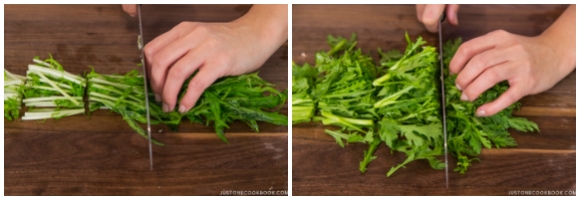





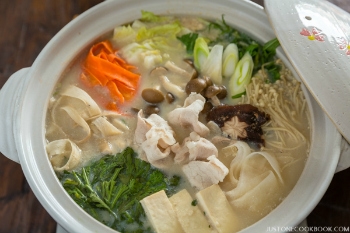











Hi, is it okay I sub the soy milk with another alternative milk like almond milk or coconut milk? Thanks.
Hello there, Bella! Soy milk tastes better in this dish and has the right flavor.
Some readers claim almond milk worked, but we haven’t tested it yet. Please let us know how it goes if you try it.
[…] Mushroom Salad with Sesame Dressing Shabu Shabu Sukiyaki Soy Milk Hot Pot Kimchi […]
Hi Namiko, I’m very excited to try this recipe. What type of soy milk do you recommend? I live in London and the type of soy milk from the supermarkets are unlike the type you get in Asia which is thicker. Will the former type work? 🙂
Hi Mel! Thank you very much for reading Nami’s post and trying her recipe!
We recommends any unsweetened soymilk even Asian ones. If it’s too thick for your taste, please dilute it with more dashi.🙂
We hope this helps!
Thank you for your recipe. The broth taste was extraordinary. Miso and soy milk are truly a matched made in Heaven.
The only “alteration” I made is that I used a bottle of sesame sauce since I did not have ponzu sauce left.
Hi Sakura! Thank you very much for trying Nami’s recipe and for your kind feedback!
We are so happy to hear you enjoyed Soy Milk Hot Pot!
Can you recommend a good hotpot to buy?
Hi Janice!
Nami buys her Donabe from https://toirokitchen.com/
You can also check here; https://www.amazon.com/dp/B004VKTQMI/?ref=exp_justonecookbook_dp_vv_d
We hope this helps!🙂
Do you think you almond milk can be used instead of soy? I know it might not taste the same
Hi Mars! Personally, soy milk tastes well in this recipe and it has the right flavor… but some readers say almond milk worked. I haven’t tried it myself though. 🙂
[…] 7. Soy Milk Hot Pot […]
Right after I poured in soy milk, it curdled:
I guess the water was too hot? I couldn’t taste any soy milk, I think because it curdled.
Hi hmucha! Did you microwave till it’s warm? It should be warm when it’s added. And any soy milk hot pot DO curdle. Even at a restaurant or cooking at home… you just have to remove them, use lower heat. However, it will only start to curdle after you put all the ingredients and start cooking. 🙂
I have made this recipe twice. First time, my family like the soy milk broth flavor which were made from store brought soy milk. but we were little bit distracted by the vanilla additional flavor which were added in the cartooned soy milk. Tonight I made this soy milk hotpot with my homemade soy milk made from scratch. The broth came out tastier. Thanks for sharing the recipe.
Hi Nana! Thank you so much for trying my recipe! OH! Can you find the unsweetened original soymilk (not sweet, no additional flavor) at your store? But I guarantee your homemade soy milk is far better than store-bought one! I’m jealous! It must have been such a wonderful hot pot! 🙂
Yes, home made soy milk came out creamier. My husband love hot spicy taste. So I completed the soup with the hot spicy sauce. Mixture of chillies (a lot of it🌶️🌶️🌶️) , grinded sesame seed, miso, soy sauce, and palm sugar. It was a nice additional taste for the soup.
Wonderful, thank you for sharing it Nana! 🙂
[…] My kids like the “Chocolate” flavor, but I almost always buy the “Unsweetened” version so I can use it to make savory dishes like Vegetarian Ramen and Soy Milk Hot Pot. […]
This looks amazing!! Does it reheat well as leftovers? How long will it keep in the refrigerator? Thanks!!
Hi Maria! I reheat my hot pot, but only keeps for 24 hours and no more than that. 🙂
Hi pls send me recipes. Thank you!
Hi Hilda! The recipe is inside the blog post. You can print out using a print button if you like. 🙂
I made this hot pot tonight. It was incredible!! It was super easy. I am not sure if would go back to regular hot pot after this one. Thank you for the amazing recipe.
Hi Naoko! Haha yeah I know what you mean. We had Chankonabe over the weekend and tonight we had Shabu Shabu. We felt it’s a bit plain too. LOL. So happy to hear you enjoyed it. Thank you for your kind comment!